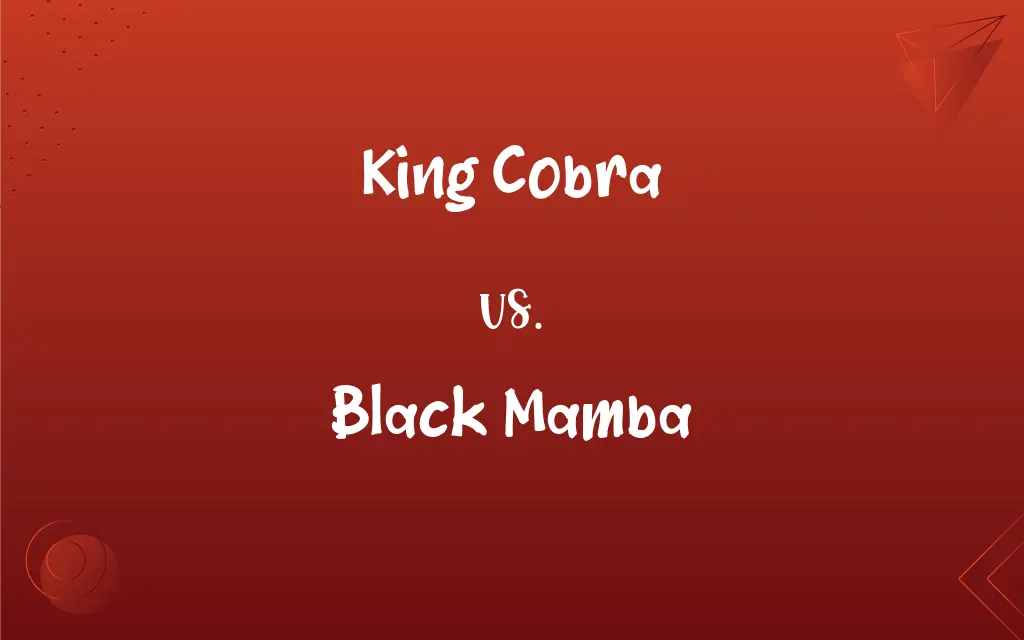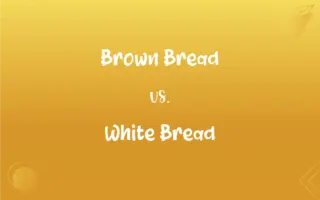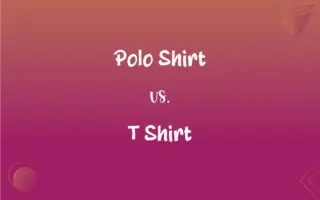King Cobra vs. Black Mamba: What's the Difference?
Edited by Aimie Carlson || By Janet White || Published on January 4, 2024
The king cobra, a large venomous snake known for its hood and intimidating posture, contrasts with the black mamba, a highly agile and fast snake, infamous for its potent venom.

Key Differences
The king cobra, famous for its large size and distinctive hood, differs markedly from the slender, more streamlined black mamba.
King cobras are primarily found in forests and plains of South and Southeast Asia, whereas black mambas inhabit savannas and rocky hills of sub-Saharan Africa.
King cobras, known for their intelligence and ability to stand up to confront threats, are unlike black mambas, which are aggressive when cornered and extremely fast.
Both snakes are highly venomous, the black mamba's venom is more lethal than that of the king cobra, which has a neurotoxic venom affecting the respiratory system.
The king cobra holds a place of reverence and fear in many Asian cultures, in contrast to the black mamba, which is often associated with fear and danger in African folklore.
ADVERTISEMENT
Comparison Chart
Size and Appearance
Larger with a hood; up to 18 feet long.
Slender, up to 14 feet long.
Habitat
Forests and plains in Asia.
Savannas and rocky hills in Africa.
Behavior
Can stand up; generally avoids humans.
Extremely fast and aggressive.
Venom Potency
Neurotoxic, affecting the nervous system.
Potent, fast-acting venom.
Cultural Significance
Revered and feared in Asian cultures.
Associated with fear in African cultures.
ADVERTISEMENT
King Cobra and Black Mamba Definitions
King Cobra
King cobras are revered in many Asian cultures.
In local folklore, the king cobra is often seen as a guardian spirit.
Black Mamba
The black mamba is a highly venomous snake found in Africa.
The black mamba, known for its speed, disappeared into the grass.
King Cobra
The king cobra is a large venomous snake native to Asia.
The king cobra slithered through the underbrush, its hood expanded.
Black Mamba
Black mambas are one of the fastest and most agile snakes.
The black mamba moved with incredible speed, evading capture.
King Cobra
King cobras are the world's longest venomous snakes.
The king cobra we saw was over 15 feet long, a true giant.
Black Mamba
Black mambas are usually olive or grey, not black.
The black mamba we observed was a dark olive color, blending with its surroundings.
King Cobra
King cobras primarily feed on other snakes, including pythons.
The king cobra is an adept hunter, preying on a variety of snakes.
Black Mamba
Black mambas have a potent neurotoxic venom.
The bite of a black mamba can be fatal without prompt antivenom treatment.
King Cobra
King cobras are known for their distinctive hood and intimidating posture.
When threatened, the king cobra raises its head and spreads its hood.
Black Mamba
Black mambas are often feared in African folklore.
In many African stories, the black mamba is a symbol of danger and death.
FAQs
What color is the black mamba?
Despite its name, the black mamba is usually olive, brownish-grey, or metallic grey.
Are king cobras aggressive towards humans?
King cobras generally avoid humans but can be aggressive if cornered.
Can king cobras be tamed?
While they can be habituated to human presence, king cobras are wild animals and not truly tameable.
How fast can a black mamba move?
Black mambas can move at speeds of up to 20 km/h (12 mph).
How long can king cobras grow?
King cobras can grow up to 5.5 meters (18 feet), making them the longest venomous snakes.
What is unique about the black mamba's venom?
Black mamba venom is extremely potent and fast-acting, causing paralysis and respiratory failure.
What do king cobras eat?
King cobras primarily feed on other snakes, including venomous species.
Where are king cobras found?
King cobras are found in forests and plains of South and Southeast Asia.
How do king cobras defend themselves?
King cobras defend themselves by standing up, expanding their hood, and hissing.
How do black mambas reproduce?
Black mambas lay eggs, typically in burrows or hollow tree trunks.
How does the black mamba get its name?
The black mamba gets its name from the black coloration inside its mouth.
What is the conservation status of black mambas?
Black mambas are not currently listed as endangered or threatened.
What role do king cobras play in their ecosystem?
King cobras help control the population of other snakes, maintaining ecological balance.
What should you do if you encounter a black mamba?
If you encounter a black mamba, keep a safe distance and do not provoke it; slowly back away if possible.
Do king cobras have any natural predators?
Adult king cobras have few natural predators, but young ones may be preyed upon by birds and other snakes.
Can king cobras swim?
Yes, king cobras are capable swimmers and are often found near water bodies.
Do black mambas climb trees?
Yes, black mambas are adept climbers and can be found in trees while hunting or resting.
What habitat do black mambas prefer?
Black mambas inhabit savannas, rocky areas, and occasionally dense forests.
Are black mambas solitary?
Yes, black mambas are solitary snakes, only coming together for mating.
What is the life span of a king cobra?
King cobras can live up to 20 years in the wild.
About Author
Written by
Janet WhiteJanet White has been an esteemed writer and blogger for Difference Wiki. Holding a Master's degree in Science and Medical Journalism from the prestigious Boston University, she has consistently demonstrated her expertise and passion for her field. When she's not immersed in her work, Janet relishes her time exercising, delving into a good book, and cherishing moments with friends and family.
Edited by
Aimie CarlsonAimie Carlson, holding a master's degree in English literature, is a fervent English language enthusiast. She lends her writing talents to Difference Wiki, a prominent website that specializes in comparisons, offering readers insightful analyses that both captivate and inform.






































































